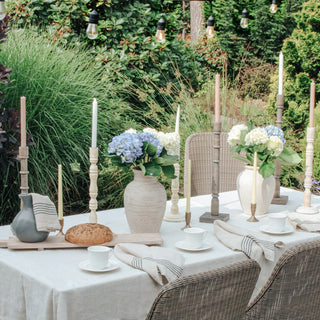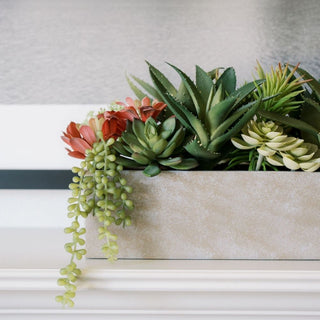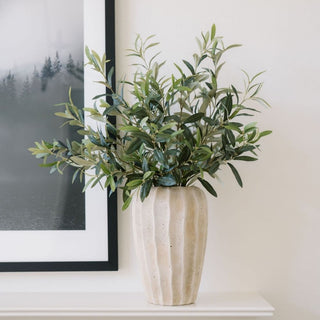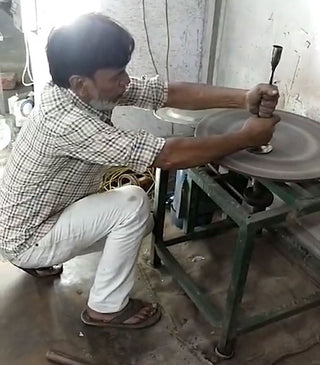Where Science Meets Style
Neuroaesthetics is an emerging field at the intersection of neuroscience and design. It investigates how our brains respond to beauty, harmony, and spatial environments, helping designers create spaces that actively improve mental and emotional well-being. While originally rooted in psychology and art theory, this scientific approach has found a powerful foothold in interior design. As Biofilico explains, neuroaesthetics enables “a science-based approach to designing environments that are aligned with our biology, and ultimately, our wellbeing.” This holistic view of design—blending form, function, and neuroscience—has elevated interior design into a wellness practice. Elements like natural light, biophilic patterns, and symmetry stimulate our brains in ways that reduce stress and boost focus.
At CG Hunter, these insights are foundational. Our artisan-crafted decor isn’t just visually pleasing—it’s meant to feel good. Our vases, faux stems, and handwoven rugs are chosen with sensory intention. Whether it’s the grounding sensation of a jute pouf or the calming effect of a green plant, each piece is meant to contribute to your space’s emotional resonance.
The Emotional Architecture of Home
 The moment you step into a room, your brain is already processing its emotional landscape. It instinctively asks: Is this space calming or chaotic? Welcoming or clinical? These immediate assessments are governed by the limbic system—the emotional and memory center of the brain. As described in Home Accents Today, our nervous systems respond within milliseconds to environmental stimuli like texture, shape, spatial arrangement, and lighting. These subconscious reactions shape not only how we feel, but how we function in a space.
The moment you step into a room, your brain is already processing its emotional landscape. It instinctively asks: Is this space calming or chaotic? Welcoming or clinical? These immediate assessments are governed by the limbic system—the emotional and memory center of the brain. As described in Home Accents Today, our nervous systems respond within milliseconds to environmental stimuli like texture, shape, spatial arrangement, and lighting. These subconscious reactions shape not only how we feel, but how we function in a space.
The field of neuroaesthetics offers a profound explanation for this phenomenon. According to MXD Interiors, elements such as symmetry, spatial harmony, and light diffusion have measurable effects on emotional regulation and mental clarity. Spaces that incorporate curved lines, balanced negative space, and natural materials are shown to lower cortisol levels and promote cognitive calm. Conversely, rooms overwhelmed by visual noise—harsh lighting, angular furniture, or excessive contrast—can activate stress responses and mental fatigue. Have you ever tried to focus on a task in a chaotic room? It can feel next to impossible, and this may be way. This explains why even beautifully designed interiors can feel “off” when they are not emotionally attuned.
Biofilico elaborates further by emphasizing the power of “sensorial integration,” or how multiple sensory channels (touch, sight, and even scent) interact to affect our internal equilibrium. A room's material palette—wood, glass, textiles—should create harmony not only with the eye but also with the body's deeper instincts. This aligns with the neuroaesthetic principle that we don't just see a space—we experience it viscerally.
Whether it’s a calming entryway or a serene living room corner, each CG Hunter item contributes to what The Seattle Times guest writer, Sarah Walker, calls “a home that supports psychological safety and sensory nourishment.” This is the future of interior design: spaces not only built for beauty, but built to make us feel more human, more grounded, and more at peace. This works with both real and artificial plants!
Designing for Wellbeing: Biophilia and Texture
Biophilic design, a cornerstone of neuroaesthetic philosophy, centers on our inherent affinity for nature. According to MXD Interiors, biophilic design is “not a trend, but a design philosophy”—a foundational principle rooted in human biology. It goes far beyond including plants for aesthetic appeal; it’s about thoughtfully integrating natural elements into our living environments in ways that support mental and emotional well-being. This means incorporating forms, materials, and textures that mirror the natural world—wood grains, woven fibers, stone finishes, or leafy silhouettes—all of which the human brain recognizes as calming and familiar.
The power of biophilic design lies in its subtlety. As outlined in Biofilico’s article on neuroaesthetics, exposure to natural materials and shapes—especially those mimicking nature’s fractal patterns—can significantly reduce stress, regulate heart rate, and even improve cognitive performance. Importantly, the brain doesn't require these inputs to be real; it responds to the representation of nature. As Home Accents Today points out, even artificial greenery and natural motifs can deliver similar neurological benefits to real-life exposure.
We select materials like jute, clay, and hammered glass not just for their artisan heritage, but because they echo the tactile irregularities of nature—what the Seattle Times describes as a “tactile experience that helps regulate emotional states.” These textures have been shown to lower cortisol levels, especially when used in spaces of pause like bedrooms, reading nooks, and living rooms.
Through deliberate materiality and soft, organic styling, CG Hunter’s pieces foster environments of sensory calm. Every product—whether it’s a rug, vase, or lifelike greenery—is chosen with the knowledge that it will influence not only the style of a space, but also the psychological experience within it. In that way, our design process is as much about feeling as it is about form—turning your home into a luxurious retreat that supports peace, clarity, and emotional wellness.
Color Psychology and Mood Design

Color isn’t just aesthetic—it’s neurological. Our brains interpret color as a survival mechanism, mapping emotional meaning to hue based on evolutionary and cultural associations. As Biofilico explains, a strategic color palette “can modulate arousal levels and support emotional regulation,” influencing everything from productivity and calm to connection and creativity. Cool tones like soft blues, sage greens, and dusty lavenders are known to activate the parasympathetic nervous system, the part of the brain responsible for rest and relaxation. This makes them ideal for bedrooms, reading corners, and wellness-focused spaces. Conversely, warmer tones—think terra cotta, peach, and muted marigold—stimulate the limbic system, encouraging a sense of comfort, familiarity, and belonging. These colors work beautifully in kitchens, dining rooms, and social gathering zones.
Yet, as noted in MXD Interiors, it’s not just about choosing the “right” color—it’s about balance and placement. Oversaturation or clashing tones can cause visual fatigue, triggering overstimulation or irritability. Designers practicing neuroaesthetic principles consider how color interacts with texture, light, and proportion. A pale blush wall might feel flat on its own, but paired with natural fibers and soft shadowing, it becomes layered and comforting. Similarly, a deep navy vase might feel imposing until it’s softened by floral stems or diffused daylight. These details matter in emotional design.
At CG Hunter, we apply color psychology by curating pieces that speak to emotional neutrality and sensory ease. Our hand-selected glass vases come in earthy blues and greens that catch and refract light subtly, giving rooms a grounded but luminous quality. Our faux florals avoid anything overly saturated or synthetic; instead, they feature creamy whites, soft greens, and blushes that mimic the calming palette of nature. Our tabletop pieces, from planters to trays, rely on tone-on-tone finishes and finishes that age gracefully—reminding the brain of stability, craftsmanship, and calm. You won’t find jarring neons or overstated hues in our collections. We believe in visual rest: tones that are easy on the eyes, harmonious to live with, and timeless across seasons.
This approach isn’t just about making a space look “pretty.” It’s about crafting an atmosphere that reinforces mental clarity and emotional comfort—a kind of quiet luxury that doesn’t shout for attention but lingers in how a room feels. In this way, color becomes a tool not just for design—but for wellness.
Curating with Purpose: From Object to Atmosphere
Neuroaesthetic design encourages us to shift our approach from simply decorating with beautiful objects to intentionally curating meaningful, emotionally intelligent spaces. This principle asks us to consider not just what we place in a room, but why—how each element contributes to atmosphere, shapes mood, and impacts mental well-being. As The Seattle Times eloquently puts it, “a home is not just a container of things but an atmosphere that supports your psychological wellbeing.” That atmosphere is deeply influenced by tactile cues, visual rhythm, and the emotional associations triggered by form, color, and scale. We’re not merely collecting pieces—we’re orchestrating experiences. The act of curation becomes less about aesthetics in isolation and more about achieving harmony between environment and emotion.
At CG Hunter, this curatorial mindset informs every collection. Our design philosophy centers on the belief that a home should feel as good as it looks. Our products aren’t chosen solely for trend value—they’re selected for their potential to ground, uplift, and inspire. When styling a corner, it’s not just about filling space. It’s about how light interacts with glass, how greenery softens angular furniture, or how organic materials like woven jute underfoot create a feeling of warmth and welcome. As we detail in our article on 2025’s Top 10 Home Decor Trends, emotional design is a rising priority—and CG Hunter has long been rooted in this human-centric approach. We see furnishings as functional art, but also as tools for sensory engagement and spatial clarity.
The concept of biophilic texture is particularly important in neuroaesthetics. Whether it’s a terracotta vase that evokes the earth or a hammered glass vessel that diffuses light gently, each CG Hunter piece is designed to engage the senses subtly and continuously. For instance, our faux trees go beyond decoration—they are rhythmic vertical elements that visually calm a room. As we shared in our guide on why faux plants are essential for biophilic interior design, even the illusion of nature—if done well—can lower cortisol and restore cognitive balance. The brain doesn't require literal nature to benefit; it simply needs texture, depth, and form that mimic natural systems.
According to Home Accents Today, visual rhythm—such as the repeated curve of a vase collection or the symmetry of a rug in proportion to a seating area—creates neurological calm. We are wired to respond to these patterns instinctively. That’s why our artisans shape pieces that provide structure without rigidity, softness without visual clutter. Whether it’s a soft linen napkin, a vase with hand-thrown irregularities, or a woven ottoman that invites you to pause and sit, each object plays its role in a neuroaesthetic story.
Take, for example, a CG Hunter jute rug. Its material composition and neutral palette provide grounding both visually and physically. The slight variance in fiber, the tactile detail underfoot—it slows the rhythm of the room, inviting a mindful pace. Pair that with a corner styled with a faux olive tree, and you have a curated moment that’s not only photogenic but psychologically replenishing. The textures, colors, and forms do more than “match”—they soothe, stabilize, and stimulate the senses without overstimulating the mind.
Ultimately, neuroaesthetic curation challenges us to ask the deeper questions: What is this space doing to my state of mind? How does this color make me feel first thing in the morning? Is this corner energizing me or distracting me? In answering those questions, CG Hunter offers more than decor—we offer tools for emotional clarity. Each vase, tree, rug, or accent was chosen not just to fill a catalog, but to contribute to a more conscious, livable home. When you style with purpose, your environment becomes a sanctuary. And when each object supports your wellbeing, luxury becomes something deeply personal.
The Future of Design Is Neuroscience-Informed
 As more research emerges linking design and cognitive function, the future of interior aesthetics is clear: we’re entering the era of neuroscience-informed homes. Design is no longer just about visual appeal; it's about neurological impact. According to Biofilico, “design decisions—consciously or unconsciously—can have a profound influence on human biology and behavior.” This means that the colors we choose, the textures we favor, even the placement of a chair or a vase, affect our nervous system in measurable ways. In this new era, designers are not merely decorators—they are wellness advocates, curators of emotional landscapes, and guides for mindful living.
As more research emerges linking design and cognitive function, the future of interior aesthetics is clear: we’re entering the era of neuroscience-informed homes. Design is no longer just about visual appeal; it's about neurological impact. According to Biofilico, “design decisions—consciously or unconsciously—can have a profound influence on human biology and behavior.” This means that the colors we choose, the textures we favor, even the placement of a chair or a vase, affect our nervous system in measurable ways. In this new era, designers are not merely decorators—they are wellness advocates, curators of emotional landscapes, and guides for mindful living.
This shift is not limited to avant-garde architecture or clinical spaces—it’s moving swiftly into luxury residential design, and increasingly, everyday homes. As MXD Interiors points out, “the goal is to improve not just how a home looks, but how it supports its inhabitants' lives.” Informed clients are asking different questions: Does this space foster calm? Will this object help me feel grounded? How does my environment reflect and support my personal rhythms? The emphasis is turning toward living intentionally—and spaces that elevate both form and function.
At CG Hunter, we’ve long been committed to these principles—well before neuroaesthetics became a buzzword. Every piece we create is grounded in purpose. Whether it's the tactile texture of hand-braided jute or the calming presence of a sculptural faux tree, our collections are quietly attuned to the emotional atmosphere they help build. This growing body of research validates what we’ve always believed: that beauty without soul, without purpose, is hollow. A glossy surface may catch the eye, but it’s a meaningful form that holds our attention, anchors a room, and fosters a sense of belonging.
Our design philosophy goes beyond trends. It honors the role of home as a sanctuary, a refuge, and a deeply personal extension of our wellbeing. That’s why our products are created not just to be seen—but to be felt. Whether you're designing a meditative corner to decompress, a welcoming entryway that sets the emotional tone for your day, or a joyful holiday tablescape filled with light and warmth, CG Hunter helps you create more than a look—we help you shape an experience. Our goal is to elevate your home’s potential—one handmade piece, one intentional vignette at a time.
Neuroscience may now offer the data, but the feeling of a well-designed space has always been instinctual. CG Hunter simply helps you design with that instinct in mind. As the field of neuroaesthetic design grows, we will continue to innovate around what matters most: how your home makes you feel.
Your Turn: Share the Story of Your Space
Design is personal—and powerful. Every texture, color, and object you bring into your home contributes to the emotional narrative you’re crafting. At CG Hunter, we believe that design should not only reflect your taste but enhance your well-being. That’s why we want to hear from you: How have you brought neuroaesthetic principles into your home? Have you experienced the quiet grounding of a jute rug beneath your feet, or the subtle joy that comes from placing lifelike greenery in an otherwise static corner? Maybe it’s the way a soft-glass vase catches morning light or how a thoughtfully curated entryway sets the tone for your entire day.
These moments—these design choices—matter. They shape how we feel and how we move through our spaces. As the field of neuroaesthetics reminds us, our homes are more than shelter. They are emotional ecosystems. And the more we learn from one another, the better we become at creating homes that heal, restore, and inspire.
We invite you to join the CG Hunter community and share your journey. Tag us @CGHunterHome on Instagram, Pinterest, or TikTok and show us how you’ve brought intention, texture, and beauty into your home. Whether it’s a cozy nook with layered rugs, a dining space styled for mindfulness, or a vignette of natural materials and warm lighting, your story could inspire someone else to rethink how they design their own environment.
For more handcrafted decor inspired by wellness and beauty, browse our curated selections on Etsy, Amazon, and Wayfair. With CG Hunter, you’re not just decorating—you’re designing a space with soul, depth, and emotional intelligence. Because your home deserves more than style—it deserves to make you feel something.












